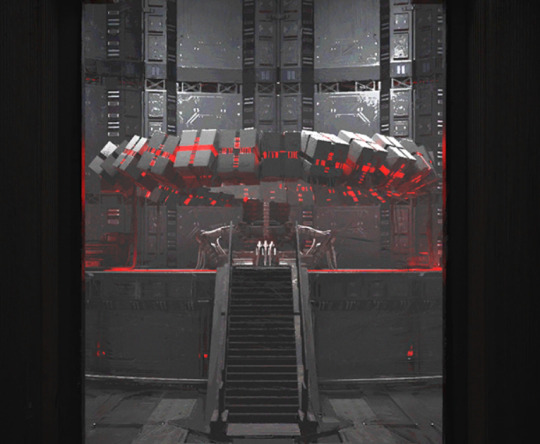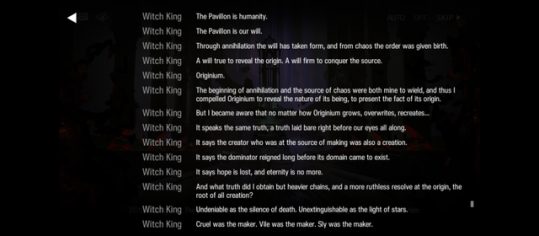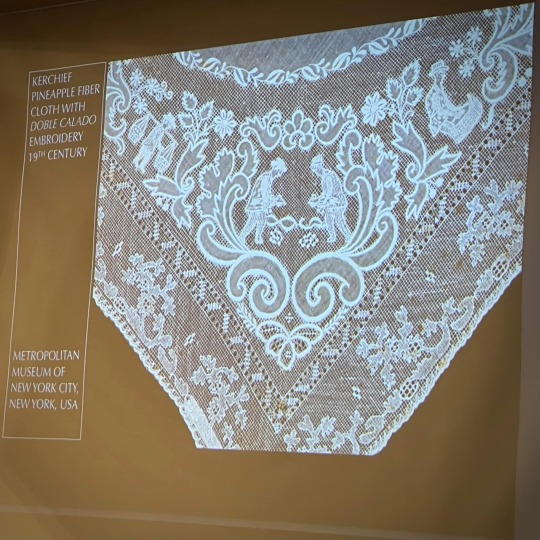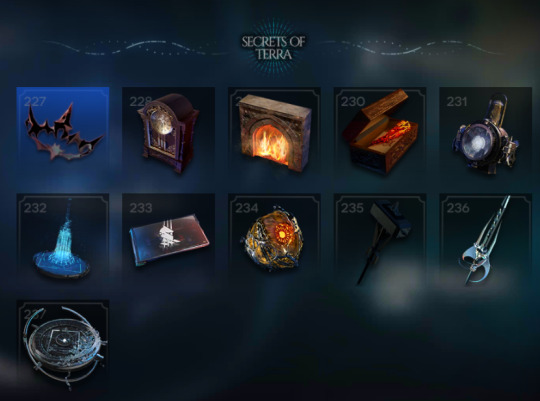#introducing will seaborn
Explore tagged Tumblr posts
Text

no way don qu- anyway i wonder if i'll get to see him on that aegir event since his last appearance was with ulpianus
#ulpianus introducing last knight to his aegir people : yes his body is (almost) fully composed of seaborn#no he won't bite#i like his rocinante#like in the world of arknights how do you even get a whole ass horse AND then turn it into seaborn#i won't be surprised it was a seaborn he tamed or seaborn that fall offs from his body and grow into a horse
22 notes
·
View notes
Text
I find it odd when people frame lore revelations as being some sort of opposite to character development as they often are pretty heavily connected.
There are tons of examples like the mechanics of how the seaborne works being actively thematically important for multiple of the stories with them for example.
Kal´tsit being a synthetic being created by a now gone precursor civilization isn't just random lore fluff, it informs her character. Why she feels isolated and set apart from people and it makes her strong love for the people of Terra more meaningful because it would be easier for her to justify that she does not have to care about them because she is not one of them. But she does care about them! She considers herself part of Terra and responsible for helping people, something which clearly makes her feel very guilty for "failing".
spoilers for Babel event and chapter 14 below:
The doctor´s entire motives for betraying Theresa only make sense from their past and the goals of the precursor civilization. Those reveals do not undermine the character drama but enhance it, the contrast between the doctor wanting to be able to help people like Kal´tsit, Amiya or Theresa clashing with their mission to ensure originium absorbs everything. They know what they are doing is wrong but they feel like all choices are wrong and the one they have a duty to fulfill is the one that required betraying Theresa. I also think a nice detail is after the doctor made up their mind to betray Theresa they start referring to Kal´tsit as AMa-10 in their inner monologues and stop trying to think about Amiya at all. Pressumably sort of trying to dehumanise or ignore the people they know they will hurt because it makes it psychologically easier for them to go through with it, this is especially notable since the doctor gave Kal´tsit her name in the first place.
And when we get a bunch of weird reveals about originium and the past civilization in chapter 14... its mainly used to get some interesting character interactions between Kal´tsit and other characters and to facilitate the situation that allows for the confrontation with Theresa, also the stuff relating to the sarkaz souls stuck there is to explain why Theresa would willingly work with Theresis despite his uhm... evil aspirations, furthermore it is also to finally reveal a bit more about what Priestess was actually like as a character.
Heck back in Lone trail while the stronger character stuff was elsewhere (I especially love the Ifrit and Rosmontis focused stuff) the sarcophagi and Friston stuff is mostly to give some more insight into characters like Ho´oleyhak, Kal´tstit and doctor, introducing us to Mark Max and giving an actually believable reason for Kal´tsit having to burn her bridges with the Tin Man, causing Rhodes to be in pretty hot water with the Columbian government.
I find the idea that the story is deciding to "stop doing character focus to do lore" absurd quite frankly.
World building is important! What makes Arknights unique compared to a lot of other popular gacha games is in large part the world and history. Arknights characters are well written, but in particular they are well written in the sense that Arknights is good at showing how the world they live in shape people into who they are. Learning more about that world to explore it in greater depth is not contradictory to the goal of interesting character writing, it helps it.
#arknights#kal'tsit arknights#the doctor arknights#doctor arknights#this great land of terra#i should write something about how terra itself is actually characterised pretty interestingly sometime
99 notes
·
View notes
Text
💧Hydro-selenokinesis (Moon Pool manipulation) power overview!🌕

I was really interested in going further with this power so I made a new moodboard for it as well as some more in depth aspects that I've fleshed out a little bit more.
Much like how Emma and Rikki's powers are opposite, hydro-selenokinesis users share a connection to Cleo's (although theirs is complimentary as opposed to opposites) since they share the same general aspects (hydrokinesis).
The use of this power also introduces into the canon that Cleo cannot control the water in any Moon Pools. A user of this power is the only one who can use hydrokinesis on Moon Pool water. (although moon pool water can be boiled/hardened by any other power, it just can't be controlled).
Limited Powers Users of this power can control any moon pool water, even if it has been taken out of the moon pool and brought back to the mainland. They can control and shape it in any way that normal hydrokinesis users can. They also feel an enhanced empathy towards the aspects of any moon pool, although their empathy is strongest towards the moon pool they changed in. They are able to feel when certain planetary alignments are coming, feel the magnetic pull of the pool, and even when they're far away they can feel if anyone has entered or exited it. They also know if someone has entered the pool during a full moon and undergone transformation. Users can also imbue the magnetic pull of the moon pool into the water and allow it to float independently of their powers (like the experiments that Lewis and Cleo did in Season 3). Finally, the user can also turn any water into moon pool water. This is convenient because it can allow the user to use hydrokinesis away from the moon pool, but it does immediately create magic water, which can quickly develop a mind of it's own. The user can try to turn it back into normal water, but if the moon pool water has gained enough "sentience" it can't be switched back and has to be returned to a moon pool or else it could go awry.
Enhanced Powers (Season 2 Planetary Alignment) The enhanced version of this power allows the user to do a lot more. On top of their original hydrokinesis, they also develop the ability to channel full moonlight, although it's significantly weaker than normal moonlight. The moonlight beams can be used to distract other mermaids, be used simply as a light source, or reveal certain things that could only be known during a full moon. It can also allow the user to generate one of the Season 3 water tentacles outside of a full moon, although it will not be strong enough to attack merpeople at that time. An inconvenient aspect of this, however, is that a merperson has a potential, on a full moon, to literally generate moonlight off of their body and in turn moon spell any mermaids in their vicinity. On top of this, they are also able to manipulate and change any moon pool rock or sand, and locate moon pool crystals (this power is very instrumental in rebuilding the moon pool after the events of Season 3).
For people out there that like M*ko M*rmaids, I think this power also fits seamlessly into their canon, as it allows seaborn mermaids to control and shift aspects of what is essentially their home.
I may add more onto this later, but thank you for reading if you did and let me know your opinions!
24 notes
·
View notes
Note
Super Sankta 2 Exu sounds like an excellent idea Zerav. For maximum meme, she's a John Wick style Guard- just uses guns to bash in people's skulls.
Super Sankta 2 Exu whose going John Wick style on people is funny but my concept for Exia Alter was always based on like, the concept that Skadi Alter first introduced that we all thought at the time was gonna be the standard fare for alters
My Ultimate Sankta vs Exia 3 concept was based around the idea of a "Bad End" Exia the way Skadi Alter is, where Exia would be further mechanized ala Executor and become an emotionless seraphim-type unit who would essentially be the ultimate Sankta weapon. This would happen as the result of Laterano having some kind of big event that would cause them to pull all remaining Sankta from all corners of Terra for their promised day of ascension where they would leave Terra and all its problems behind, with certain Sankta (Like Exia) essentially being the vanguards and protectors of these people (I essentially just took the idea of the Rapture and assigned it to the Sankta), with the event concept in question being Penguin Logistics invading this holy land to save their girl.
So like. you can imagine how hard ive been popping off with all the new lore reveals we've gotten over the past 2 years. That said, this concept is a little outdated, and just leaving it at that would be no fun
So here's my pitch for how Exia Alter 4: The Quest For Peace would go with modern foresight (added read more because reasons)
The Popes basement computer in Zwillingsturme just let out a directive that they need to gather their best Sankta to fight against the end of the world. This is in conjunction with the last few events squarely tying together Iberia's Seaborn plotline with both Laterano and Siracusa and their dividing faiths. Now, all of this is in conjunction with the hints we've been getting that Penguin Logistics is going to split up (Lappland and Mostima have already flown the coop, and currently the rest are in Siracusa helping Texas the Amogus, but that will likely not last especially bc Exia's own anniversary line all but majorly hints at this split happening because they all got different stuff going on)
If Penguin Logistics splits, Exia will well and truly be left without a support system.
Now, Exia has always been kind of off as far as Sankta go, because for all intents and purposes she shouldn't be out of place: We see just how Sankta tend to act in Guide Ahead, and Exia didn't really seem all that different. Yet, when we look at her history and actions (she was basically kicked out, she was super accident prone which made other Sankta hate her, as part of Penguin Logistics shes constantly drunk, Texas herself says that Exia being an optimist makes her different, etc), she's actually Really different.
Almost like she has an abnormality compared to other Sankta. Me and a few others (check out @annierosaart post here) have speculated on her being different, but we also don't really know WHY: Even if she was suddenly disconnected from the Sankta empathy powers, we don't see any indication of how, and unlike Ezell we don't have any sort of 'wake-up' moment for her.
But given the weirdness about her and her lines, I think I know what the exact nature of her abnormality may be (and heres my pitch) when looking at the most relevant characters who have abnormalities, namely Executor and Arturia, because I think she falls in line with them (shameless plug to my old exia/executor buddies post):
Executor's abnormality is that his emotions are incredibly muted compared to others. He isn't heartless or emotionless, but more that his heart and mind runs on rationale and logic first and foremost, which almost disqualified him from being canonized had he also not been Laternos single most competent man because saint fedex is entirely disconnected from caring about petty things like being racist.
Arturia's abnormality is that she is receptively empathetic to the point she has nothing within her. She can remove the inhibitions of people, and this is in service to understanding them, because she lacks an understanding of herself: She has a grand dream of an empathy for the world even beyond the Sankta Empathy power, and to accomplish this she draws out the emotions that people hide. As a result, she reflects the emotions of others within herself and thus is incredibly empathetic to the point she's also lacking in emotions and a self.
Exia? I think that her abnormality is that she's too emotional, that the emotions she feels are far more amplified compared to others.
I believe this for a couple of reasons: All the weirdness surrounding her aside, whats the one thing that's always defined Exia? Her Rapid Casting EX. It's always been memed about, but simply firing a single bullet from a gun is akin to casting an Arts attack, with guns serving as a type of wand in these cases. Exia is the only character within the series whose been noted to be so fast with her arts and casting.
This post here does a phenomenal job expanding on this point, but Arts are an expression of the soul, they're influenced by emotions and become stronger with them because they are ultimately expressions of the self, which all characters in and of themselves having a "unique" arts inherent to them. Hell, all of Leithaniens arts are based around using musical expression, while Sarkaz are noted for their arts based on souls and memory, with the literal main heroine of Arknights having an empathy based arts superpower.
Exia, having Super Emotion as her Sankta halo abnormality, could explain why shes so good at gun, even without Oripathy, because said emotions are boosting her casting ability. Remember, anyone can use originum arts, it's just that oripathy is needed for them to be able to do it without a casting device.
This heightened emotion could also possibly explain her crush on Mostima, and even why Mostima is so weird/cruel about her: Mostima was simply a childhood friend alongside her and her sister, and yet when she left for Lungmen, Exia was hot on her trails and then waited 4 YEARS to be beside her and meet her again. She joined Penguin Logistics specifically because of Mostima. It's incredibly likely that Exia might have just had a small crush on her that then spiraled heavily because of this, and Mostima (with her chronic backstory-itis letting her find out that the whole Sankta and halo thing is a scam from her op files and events) might even be aware of this aspect of Exia, and may have wanted her to get over it, always leaving to try and make Exia move on but also always coming back because she needs to look after Exia. After all, if Exia had heightened extreme emotions, what are the chances she could die of grief? She already gets drunks regularly, and despite being cheerful and optimistic, Exia is wearing a mask hiding an incredibly depressed individual.
It could also be possible that the reason why Exia never noticed this is because while it doesn't let other Sankta feel her emotions, she can still feel that of others. She's always confused as to why back in Laterano people always accused her of being disingenuous, because can't they feel her emotions? Well, if she has Super Emotions, it could potentially be overloading her halo, so while she can receive signals, they can't be felt by others. Moreover, this mechanical aspect blends in well with her E2 art, where she is the single operator in the game without an animal/living motiff

Even other Sankta have birds and/or human statues and robotic elements (funnily enough, Executor Sniper only has crosses but even then he is clearly being themed as specifically an angel), but Exia? She has her guns, becoming wings as a ring forms with them. She's literally ascending while her wings become darker.
So what does all this mean?
Well, the Pope's basement bonzi buddy just sent out a directive for the Pope to gather the best Sankta to fight against the end of the world, and who else to recruit but a vulnerable, lonely Sankta who was kicked out for being TOO destructive? Exia's profile does make mention that despite appearances, she is also incredibly pious just like other Sankta, and if the Pope himself came knocking, wanting to give Exia a place back in Laterano, and in a high ranking, respected position no less?
She would jump at the chance, not only to be beside her sister (and possibly Mostima), but also to be accepted back into Laterano society.
Executors own halo has a mechanized element to it, where he also gains more parts to it when he goes from normalest man to saint fedex, so he likely underwent some kind of modification to go along with his promotion, especially because he also now carries an Nier Automata companion cube with him straight from the machine




If Exia is to be canonized, she might be adjusted in a similar way by The Law.
She might even be fully altered into becoming Laterano's perfect weapon to fight against the end of the world. The Witch King himself describes this approaching threat as a void of infinite knowledge which seeks to eliminate them, an unshakeable truth of existence that drives people insane.


The Creator must perish.
What better weapon to fight against such a thing than one who feels her own emotions so strongly she cannot be swayed? Or better yet, an equally as unshakeable, emotionless machine?
#forgive this humble blogger for the late reply he had simply forgor#zerav meta#arknights#this post became waaaaaaaaaay longer than intended but IM LETTIN IT ALL OUT
28 notes
·
View notes
Text
My main issue with the seaborn is that they are the least interesting part of the situation they are in, and the fact that they have been given center-stage is frankly criminal.
As always, this is my opinion and not objective fact, but I'm right and would die on this hill.
Let us imagine for a moment that literally nothing is different except that Skadi killing Ishar'mla worked, and all the sacrifices of the abyssal hunters actually did something (we'll get back to this). The only seaborn left are in scattered groups, cut off from we many, that occasionally get attracted to the Abyssal hunters so Hypergryph has an excuse to use those game mechanics.
The first theoretical abyssal hunters event is fairly similar to the Under Tides we do get. It focuses on introducing Iberia and exploring how the inquisition rules with an iron fist even after the danger has passed. Talk about the mass killing of AEgirians and how the terrified communities just let it happen. Glaadia is smitten by Kal'tsit, we get to meet Laurentina, roll credits.
The second abyssal hunters event is about exploring the golden days of Iberia before the profound silence as the Abyssals search for a way to safely return home. Focus on how the partnership with the AEgirians made them strong, and how the inquisition rose to power in the chaos and fear of the silence. They eventually find an old ship and after fighting off the obligatory small swarm of sea terrors set off to finally go home.
The third abyssal hunters event introduces us to the Atlantean AEgirian civilization. It explores the program that created super soldiers with an early expiration date, and how the political situation in AEgir allowed it. People get mad at the abyssals for attracting yet another group of sea terrors. The boss is what is left of an abyssal hunter fully lost to the transformation (perhaps this is a good time to introduce The First To Talk?).
That would be better right? I mean most of what I've described (for the first two) is actually in Under Tides and Sultifera Navis, it just gets overshadowed by the focus on the big spooky ocean monsters and how big and spooky they are.
So, enough talking about what could have been, let's talk about what is, and why it's bad enough that it got me thinking about this in the first place.
The seaborn have no personality. This is intentional. Practicing art and maintaining a sense of self is how the abyssals we do meet have managed to last this long, their self expression literally protects them from the consuming uniformity of we many. This is not, on it's own, a problem.
The fact that this is true and that the seaborn are treated in the story as the antagonist is crazy. They could have been presented in a 'man against nature' conflict sort of way, providing a situation in which the protagonists could shine on their own. Unfortunately, they didn't even do that, as is clearly shown by The Bishop and Amaia.
The most compelling enemies in Under Tides and Sultifera Navis are the church of the deep. You know, the characters that aren't seaborn. Arknights likes having complex villains, and nothing is a less complex character than a seaborn (again, by design!) so they have to bring in characters that aren't seaborn. Just don't make the seaborn the focus in the first place!
Also, by presenting the seaborn as a genuine threat they are giving justification to the Inquisition and the Abyssal Hunter project. I know there are scenes that are meant to show that these things were actually bad, but they're a bit hard to get behind when you have a whole fucking game mode set in an alternate future timeline where the seaborn are an existential threat to all other forms of life.
Another issue with going 'the seaborn are still a genuine threat' is that all the shit Skadi and the other abyssals went through apparently didn't do much, I guess. It feels like they are retroactively ruining a story we didn't even get the chance to enjoy.
I'm going to cut myself off here. There's more narrative nitpicks I have about the seaborn (Like how, just because they don't have personalities doesn't mean they have to be boring, and yet!) but they get even more into how it was executed rather than fundamental issues, and this is long enough as it is.
In conclusion: If the next abyssal hunters event's main story is 'there are spooky seaborn doing bad things, got to go stop them' again, I'm going to scream.
Part 2
#if you must make the seaborn the focus please at least make them more than spooky ocean tentacle monsters#arknights#seaborn#ramblings#under tides#abyssal hunters#sultifera navis#caerula arbor
62 notes
·
View notes
Text
I was thinking about Laurentina and her parents again and one hypothetical scene I really like the concept of is Laurentina returning to Aegir after the seaborn threat is over and taking her girlfriends to "meet the parents."
First, Laurentina introduces them to Skadi. They like her a lot, they think she is a nice (true), sweet (true), and relatively normal (extremely wrong but I do think it's reasonable that they might think that) girl.
Then she introduces them to Irene. At first they're a little surprised she's A Bird and not Aegirian but it does make sense to them, Laurentina's been stuck on land for years there's a lot that could have happened in that time. She's also a very nice girl and they do like her a lot too.
Lastly, she introduces them to noted Aegir Consul of Technology/Chief Designer of Warfare Gladiia (who they recognize, since despite having been gone for years she is like an extremely important Aegirian figure). Their first reaction on encountering Gladiia is to try to pay their respects / salute her but Laurentina just introduces her to her parents as if there's nothing at all that's unusual about the situation. At this point Laurentina's parents are like, absolutely losing it inside ("what the fuck? how does Laurentina know her and what caused them to now be dating? just what the fuck happened while she was gone/on land???)
At some point in time later, Laurentina does explain everything that's happening and then starts cackling and clowning on her parents for their reaction to Gladiia ("Oh my you should have your faces they were priceless I"m going to remember this forever.")
#arknights#specter#specter arknights#skadi#skadi arknights#gladiia#gladiia arknights#irene#irene arknights#no one knows how to keep laurentina under control not irene not skadi not gladiia and definitely not her parents. she clowns on them#relentlessly and they are forced to accept this state of affairs#abyssal hunters
80 notes
·
View notes
Text
When Cora Seaborne’s brilliant, domineering husband dies, she steps into her new life as a widow with as much relief as sadness: her marriage was not a happy one. Wed at nineteen, this woman of exceptional intelligence and curiosity was ill-suited for the role of society wife. Seeking refuge in fresh air and open space in the wake of the funeral, Cora leaves London for a visit to coastal Essex, accompanied by her inquisitive and obsessive eleven-year old son, Francis, and the boy’s nanny, Martha, her fiercely protective friend. While admiring the sites, Cora learns of an intriguing rumor that has arisen further up the estuary, of a fearsome creature said to roam the marshes claiming human lives. After nearly 300 years, the mythical Essex Serpent is said to have returned, taking the life of a young man on New Year’s Eve. A keen amateur naturalist with no patience for religion or superstition, Cora is immediately enthralled, and certain that what the local people think is a magical sea beast may be a previously undiscovered species. Eager to investigate, she is introduced to local vicar William Ransome. Will, too, is suspicious of the rumors. But unlike Cora, this man of faith is convinced the rumors are caused by moral panic, a flight from true belief. These seeming opposites who agree on nothing soon find themselves inexorably drawn together and torn apart—an intense relationship that will change both of their lives in ways entirely unexpected.


#book: the essex serpent#author: sarah perry#genre: fantasy#genre: historical fiction#genre: literary
10 notes
·
View notes
Text

Trajectories and Movements of Filipino People: Diasporic Objects and Possibilities for Rematriation, Marian Pastor Roces (Alliance Français Manila, September 7, 2024)




(Photos from Tara Illenberger, Facebook. We attended the same talk, though I was not able to take much photos as much, since I was not seated at the front. 😅)
Would like to start this post by saying that it was such an honor to have met Marian Pastor Roces again. For my would-be followers who are yet to read my blog posts, especially those who are situated abroad, I would like to introduce Marian Pastor Roces to you. MPR is an art critic, museum curator (and creator, in a comical sense), writer, political analyst, and cultural critic. She has hosted the establishments of numerous cultural initiatives that concern cultural heritage of ethnic groups in the Philippines. She is also a writer of essays and books, and an editor for Mapping Philippine Material Culture — a global archive of the different diasporic Filipino art and antiquities.
I met her the first time when I hosted a talk for her at my university. Terrific woman. I wish I had learned about her way sooner, from when I was a kid. Then, I would not have been so indecisive of what I wanted to be when I grew up and knew that I wanted to be a cultural heritage lawyer from the start, haha!
Something this talk proved further was the very principle that
cultural objects have memory too,
much like how much of the movements of Filipino people are reflected in the movements of its cultural objects.
Click read more to read the notes I got from the talk! ⬇️
There were three events that mark as significant events and turning points in the movements of the Filipino people.
Austronesian Migration: Wherein a seaborne migration set sail from the island of Taiwan to Batanes, in Northernmost Philippines. Objects traced and left behind by our Austronesian ancestors revealed marks of cultural connections along their trail.
1887 Madrid Exposition: Wherein maltreatment from the colonial Spaniards sought to display people of the Igorots in Human Zoos. The Filipino people have become an object themselves according to the colonizer.
Philippine Diaspora and Globalization: Wherein Filipino artifacts are now dispersed in cultural and archival institutions globally. Now, the material culture heritage of the Philippines is in large measure overseas. Filipinos do not have access to much of the material evidence of our heritage. Among the outcomes of this unknowing is an abyssmal loss of measures of quality that Philippine Peoples enjoyed until about a century ago.

The substantial collection of the National Museum of the Philippines was nearly totally destroyed during the Second World War, the same event which led to the adopted of the 1954 Hague Convention, briefly discussed in the previous post.
Material Culture Studies were not a significant area of work for Philippine Studies during the Post-War Period.
Philippine Material Culture collections started to be an activity in the 1970's.

What is lost to the Filipinos, as diasporic objects are detached from them?
Key pieces that embody the most ✨ sublime ✨ levels of cultural expression in material form by specific Philippine Peoples. Here, Marian does not refer to these pieces by the quantity of cultural objects being produced, but by the quality of it. You can get traditional, authentic fabric anywhere in the region where the community resides — but all the ones that were made special, limited, and ceremonious are all stored in museums abroad.
Key pieces for which no equivalent exists.
The full range of variations of certain traditions, as expressed by the artists of specific community.
The opportunities to study continuities or commonalities between and among parts of the Philippine experiences that are normally separated.
Accurate analysis of what is Philippine — and thus to inform policy.

WHO DO YOU RETURN THE OBJECTS TO? Repatriation vs. Rematriation
Repatriation:
Nation-state as destination of return.
The loss of legitimacy or ethical high ground of holdings of powerful entities.
Rematriation:
Not return to the state — but the people who made them.
Though legal processes are able to create a process for repatriation, you cannot template rematriation.
You need to built trust with the community you are rematriating to.
The Legal Practice and Rematriation:
Cultural Heritage law centers more on private/institutional ownership (i.e. cultural property). However, Cultural Heritage is inherently collective. Hence, what we need is a legal basis for cultural custodianship as well — in collaboration in both the communal (discourses among the ethnic group), and international (UNESCO).

Enumeration of Investigative Directions that will have useful impact on Policy, Governance, Philantrophy, Grassroots Work, and International Relations, with regard to Philippine Material Culture
The celebration of global peak achievements in material culture.
The acknowledgement of Philippine Material Culture as rooted in village cosmologies that are shared across island Southeast Asia.
The establishments of living links between past and future art.
The metamorphosis from village to supra village ethos.
The fullsome recognition of a different way of being human in this part of the world.

#antiquities#culturalheritage#culture#literary theory#society#literature#art#history#museums#museum studies#provenance#repatriation#reMatriation
4 notes
·
View notes
Text

Reading through hortus, on HE-5 rn
from what i'm getting, the sea monster (assumption) is the twins' mother?
alrhough unexpected it was a nice touch to introduce the church of the deep and their evolution question into this Lateran event. curious about if sanktas could get seaborned too caus im pretty sure this one is a liberi seaborn
14 notes
·
View notes
Text



Title: The Essex Serpent
Author: Sarah Perry
Genre/s: historical
Content/Trigger Warnings: emotional and physical abuse, implied death by drowning, implied death in childbirth, implied sexual harassment
Summary (from author's website): London, 1893. When Cora Seaborne's controlling husband dies, she steps into her new life as a widow with as much relief as sadness. Along with her son Francis - a curious, obsessive boy - she leaves town for Essex, in the hope that fresh air and open space will provide refuge.
On arrival, rumours reach them that the mythical Essex Serpent, once said to roam the marshes claiming lives, has returned to the coastal parish of Aldwinter. Cora, a keen amateur naturalist with no patience for superstition, is enthralled, convinced that what the local people think is a magical beast may be a yet-undiscovered species. As she sets out on its trail, she is introduced to William Ransome, Aldwinter's vicar, who is also deeply suspicious of the rumours, but thinks they are a distraction from true faith.
As he tries to calm his parishioners, Will and Cora strike up an intense relationship, and although they agree on absolutely nothing, they find themselves at once drawn together and torn apart, affecting each other in ways that surprise them both.
The Essex Serpent is a celebration of love, and the many different shapes it can take.
Buy Here: https://bookshop.org/p/books/the-essex-serpent-sarah-perry/7213198
Spoiler-Free Review: On the surface, this book is a beautifully deep and detailed historical novel, with all the right period details. It’s also a bit of a mystery/horror novel, with all those tiny nods to the (historical) legend of the Essex Serpent and the touches of folk horror in how the people of Aldwinter talk about it and deal with it.
But at its core, it's all about the characters, who are all quite complex and layered in their portrayals. None of them fits into any sort of stereotype one might find of them in Victorian novels: Cora isn’t necessarily the typical widow (merry or otherwise), William isn’t the typical parson, Martha isn’t the typical lady’s companion, etc. Each character has an idea of what the other characters are like before meeting them, then another idea of what they’re like after meeting them. That idea changes throughout the course of the novel as the plot plays out - a plot that is largely driven by the way the characters interact with each other. There’s a kind of ripple effect: one character takes some kind of action (or doesn’t), and the effects of their action or inaction affects the other characters, to a greater or lesser degree. This is what makes the characters - and the novel - enjoyable to read.
This dynamic is clearest with Cora and William. Initially they have some negative ideas about what the other is like, but when they finally meet each other in person those ideas change, and become more positive. But as the novel goes on, it becomes clear that though they get along and agree on a lot of things, there’s also plenty of things they DON’T agree on - but that just makes them more interesting to each other, more enjoyable to be around. This creates an interesting push-and-pull between them, that ripples out onto the other characters. Those characters, in turn, react to that dynamic, and their reactions spark similar reactions in other characters, including Cora and William.
Of course, none of these dynamics would be interesting if the characters themselves weren’t interesting on their own. As I mentioned earlier, none of the characters are stereotypes, but some are, I think, a bit more interesting than others - largely because of how they shine a light on aspects of British Victorian history that might not always be made obvious in other media based on the time period. The most obvious example here is Martha: her socialist politics provide a refreshing contrast to the politics of the other characters, but her sapphic-coded relationship with Cora, and her more complicated, politically-slanted relationship with Spencer, also add angles and layers to her that are not always visible in media and literature about the Victorian period.
But where does this leave the Essex Serpent itself, and its story? While it’s still a presence in the novel, and is the reason why all the characters come together in the first place, it’s really more of a symbol than any kind of actual threat. In that sense it can be viewed in many different ways, but the one I lean more towards is that it is a symbol of making assumptions, and disillusionment: two things all the characters undergo, for better and for worse.
So overall, while some readers might come to this novel expecting something in the horror or gothic vein (like I did, initially), they’ll quickly come to learn that this really is a story about the characters in it, and how they interact with and react to each other, than about any supposed monster lurking in the river. While this might be disappointing to some readers who were looking for a scarier read, others might find themselves unexpectedly delighted by the novel’s character-heavy focus and the author’s wonderful prose.
Rating: five blue stones
4 notes
·
View notes
Text
my personal pet theory about Aulus (working on the. quite warranted assumption that he is, in fact, Thorns' mentor, something that feels so true in my head i kind of forgot it was never actually confirmed in game lol) is that he skews more on the Cicero end of church of the deep bishop motivations but rather than trying to create a 'better' version of humanity, Aulus is trying to create a sort of best of both worlds intermediate between humans and seaborn that have access to the seaborne hivemind but can still retain individual human agency. let me explain
the idea of choice is present in almost everything Aulus says, both in Thorns' IS3 monthly squad and in hortus de escapisimo. as mentor to Thorns, the main thing Aulus taught him was the importance of making his own decisions, which honestly seems pretty contradictory to the nature of We Many as a hivemind where the self can be sacrificed for the good of the collective


in hortus de escapisimo, both Stephano and Arturia also comment on this as being Aulus' main motivation, with Arturia not fully buying his whole individual agency thing since she sees people's choices as being strung along by their emotions and desires

when Aulus asks Stephano if he's sure he wants to go forward with the plan to midnight mass feed seaborn to the abbey residents (and implies he thinks he's under the influence of Arturia's arts), Stephano thinks it's out of character for Aulus to question others' choices and resolve

similarly, he also planned on persuading Hyman against becoming a seaborn because he thought her judgement was clouded, which, again, doesn't seem very church of the deep bishop of him

but if independent choice and agency is so important to Aulus, why side with the seaborne? honestly i'm not 100% on this part, but my guess is that he's after the seaborn hivemind

considering the fact that Aulus also studied at the sanctilaminium ambrosi, a lateran monastery, it doesn't feel particularly far-fetched to me that an Iberian Aegir who has personally witnessed the Sankta's empathy would be interested in trying to achieve something similar on a wider scale in an attempt to bring about greater mutual understanding between individuals. in that sense, his focus on individual agency can be seen as more of a defense mechanism against being assimilated by the seaborn while he tries to take advantage of their most useful feature.
also, we have already seen him succeed in this goal. In hortus de escapisimo, Hyman spares her children despite her hunger, in spite of the collective's drive to survive, because she recognises them as her children. in the IS3 timeline, Aulus himself is implied to be something like this as well, having fully transformed into a seaborn but still being able to hold a conversation with Thorns as an individual where he once again encourages him to make his own choices.


and, similarly to Hyman, Aulus' teachings do manage to reach Thorns in the IS3 storyline (although, ironically, his individual resolve is more focused on hurting the collective after joining them)


again, this is all just speculation (lord knows when we're getting the next installment in the seaborn storyline) but since all the church of the deep bishops have gotten their own little moments of explaining what they think they're getting out of the job, this is just my personal guess at what Aulus' end goal is as our newly introduced bishop
#arknights#i should make a metas tag at this rate lol#this is just how im making up for not drawing much these days because i have like 5657213 other things im working on#(pretty ironic) fun fact but i had my msr playlist on shuffle while writing this which means#i wrote most of this post while listening to the is3/under tides soundtrack KDSJKSDJFHKDJH#also i did. in fact. make the freudian slip of typoing hyman as human at one point. really not sure if thats a bug or a feature#i actually have a bunch of in game screenshots i couldnt find a logical point to insert which#like thats kinda the main thing for me in terms of like. oh of course aulus is thorns mentor like#moreso than the iberian sword technique or referencing an old student just#the characterisation between thorns mentor in his is3 lore and aulus in hde is so consistent its like yeah of course this is the same guy#this whole post has a very thats just a theory a game theory energy but ive just been thinking about this slimy man for so long#i cant like. not write something about it. so here we are#like i wouldnt even mind being proven wrong by the game bc that at least means we're getting more iberia lore KDJSFHKSJH
2 notes
·
View notes
Text
Fic bit that doesn't have a home, may be part of a bigger fic someday:
Josh inwardly sighed as he put on his best charming smile and walked onto the stage. This. This is what he hated most. Might as well be the candidate with all smiling and hand shaking he had to do. But he had to admit, it was as all worth it in the end.
“Welcome ladies and gentlemen, thank you all for coming here tonight. Without further ado, let me introduce our featured speaker for this event, the President of the United States and my husband, Sam Seaborn-Lyman!”
6 notes
·
View notes
Text
How you can use python for data wrangling and analysis
Python is a powerful and versatile programming language that can be used for various purposes, such as web development, data science, machine learning, automation, and more. One of the most popular applications of Python is data analysis, which involves processing, cleaning, manipulating, and visualizing data to gain insights and make decisions.
In this article, we will introduce some of the basic concepts and techniques of data analysis using Python, focusing on the data wrangling and analysis process. Data wrangling is the process of transforming raw data into a more suitable format for analysis, while data analysis is the process of applying statistical methods and tools to explore, summarize, and interpret data.
To perform data wrangling and analysis with Python, we will use two of the most widely used libraries: Pandas and NumPy. Pandas is a library that provides high-performance data structures and operations for manipulating tabular data, such as Series and DataFrame. NumPy is a library that provides fast and efficient numerical computations on multidimensional arrays, such as ndarray.
We will also use some other libraries that are useful for data analysis, such as Matplotlib and Seaborn for data visualization, SciPy for scientific computing, and Scikit-learn for machine learning.
To follow along with this article, you will need to have Python 3.6 or higher installed on your computer, as well as the libraries mentioned above. You can install them using pip or conda commands. You will also need a code editor or an interactive environment, such as Jupyter Notebook or Google Colab.
Let’s get started with some examples of data wrangling and analysis with Python.
Example 1: Analyzing COVID-19 Data
In this example, we will use Python to analyze the COVID-19 data from the World Health Organization (WHO). The data contains the daily situation reports of confirmed cases and deaths by country from January 21, 2020 to October 23, 2023. You can download the data from here.
First, we need to import the libraries that we will use:import pandas as pd import numpy as np import matplotlib.pyplot as plt import seaborn as sns
Next, we need to load the data into a Pandas DataFrame:df = pd.read_csv('WHO-COVID-19-global-data.csv')
We can use the head() method to see the first five rows of the DataFrame:df.head()
Date_reportedCountry_codeCountryWHO_regionNew_casesCumulative_casesNew_deathsCumulative_deaths2020–01–21AFAfghanistanEMRO00002020–01–22AFAfghanistanEMRO00002020–01–23AFAfghanistanEMRO00002020–01–24AFAfghanistanEMRO00002020–01–25AFAfghanistanEMRO0000
We can use the info() method to see some basic information about the DataFrame, such as the number of rows and columns, the data types of each column, and the memory usage:df.info()
Output:
RangeIndex: 163800 entries, 0 to 163799 Data columns (total 8 columns): # Column Non-Null Count Dtype — — — — — — — — — — — — — — — 0 Date_reported 163800 non-null object 1 Country_code 162900 non-null object 2 Country 163800 non-null object 3 WHO_region 163800 non-null object 4 New_cases 163800 non-null int64 5 Cumulative_cases 163800 non-null int64 6 New_deaths 163800 non-null int64 7 Cumulative_deaths 163800 non-null int64 dtypes: int64(4), object(4) memory usage: 10.0+ MB “><class 'pandas.core.frame.DataFrame'> RangeIndex: 163800 entries, 0 to 163799 Data columns (total 8 columns): # Column Non-Null Count Dtype --- ------ -------------- ----- 0 Date_reported 163800 non-null object 1 Country_code 162900 non-null object 2 Country 163800 non-null object 3 WHO_region 163800 non-null object 4 New_cases 163800 non-null int64 5 Cumulative_cases 163800 non-null int64 6 New_deaths 163800 non-null int64 7 Cumulative_deaths 163800 non-null int64 dtypes: int64(4), object(4) memory usage: 10.0+ MB
We can see that there are some missing values in the Country_code column. We can use the isnull() method to check which rows have missing values:df[df.Country_code.isnull()]
Output:
Date_reportedCountry_codeCountryWHO_regionNew_casesCumulative_casesNew_deathsCumulative_deaths2020–01–21NaNInternational conveyance (Diamond Princess)WPRO00002020–01–22NaNInternational conveyance (Diamond Princess)WPRO0000……………………2023–10–22NaNInternational conveyance (Diamond Princess)WPRO07120132023–10–23NaNInternational conveyance (Diamond Princess)WPRO0712013
We can see that the missing values are from the rows that correspond to the International conveyance (Diamond Princess), which is a cruise ship that had a COVID-19 outbreak in early 2020. Since this is not a country, we can either drop these rows or assign them a unique code, such as ‘IC’. For simplicity, we will drop these rows using the dropna() method:df = df.dropna()
We can also check the data types of each column using the dtypes attribute:df.dtypes
Output:Date_reported object Country_code object Country object WHO_region object New_cases int64 Cumulative_cases int64 New_deaths int64 Cumulative_deaths int64 dtype: object
We can see that the Date_reported column is of type object, which means it is stored as a string. However, we want to work with dates as a datetime type, which allows us to perform date-related operations and calculations. We can use the to_datetime() function to convert the column to a datetime type:df.Date_reported = pd.to_datetime(df.Date_reported)
We can also use the describe() method to get some summary statistics of the numerical columns, such as the mean, standard deviation, minimum, maximum, and quartiles:df.describe()
Output:
New_casesCumulative_casesNew_deathsCumulative_deathscount162900.000000162900.000000162900.000000162900.000000mean1138.300062116955.14016023.4867892647.346237std6631.825489665728.383017137.25601215435.833525min-32952.000000–32952.000000–1918.000000–1918.00000025%-1.000000–1.000000–1.000000–1.00000050%-1.000000–1.000000–1.000000–1.00000075%-1.000000–1.000000–1.000000–1.000000max -1 -1 -1 -1
We can see that there are some negative values in the New_cases, Cumulative_cases, New_deaths, and Cumulative_deaths columns, which are likely due to data errors or corrections. We can use the replace() method to replace these values with zero:df = df.replace(-1,0)
Now that we have cleaned and prepared the data, we can start to analyze it and answer some questions, such as:
Which countries have the highest number of cumulative cases and deaths?
How has the pandemic evolved over time in different regions and countries?
What is the current situation of the pandemic in India?
To answer these questions, we will use some of the methods and attributes of Pandas DataFrame, such as:
groupby() : This method allows us to group the data by one or more columns and apply aggregation functions, such as sum, mean, count, etc., to each group.
sort_values() : This method allows us to sort the data by one or more
loc[] : This attribute allows us to select a subset of the data by labels or conditions.
plot() : This method allows us to create various types of plots from the data, such as line, bar, pie, scatter, etc.
If you want to learn Python from scratch must checkout e-Tuitions to learn Python online, They can teach you Python and other coding language also they have some of the best teachers for their students and most important thing you can also Book Free Demo for any class just goo and get your free demo.
#python#coding#programming#programming languages#python tips#python learning#python programming#python development
2 notes
·
View notes
Text
Zoople Technologies: Your Gateway to a Thriving Data Science Career in Kerala
In today's data-centric world, the power to extract meaningful insights from vast amounts of information is a highly valued skill. Data science has emerged as a critical discipline, driving innovation and informed decision-making across industries. For individuals in Kerala looking to capitalize on this growing demand, Zoople Technologies offers comprehensive data science training designed to equip you with the expertise to excel in this dynamic field.
Empowering Kerala's Talent with Industry-Relevant Data Science Skills:
Zoople Technologies understands the evolving needs of the data science landscape and has crafted a curriculum that blends theoretical foundations with practical application. Their data science training in Kerala is structured to take you from fundamental concepts to advanced techniques, ensuring you are job-ready upon completion. Key aspects of their program likely include:
Building a Strong Foundation with Python: Python is the lingua franca of data science. Zoople Technologies' training likely starts with a robust introduction to Python programming, covering essential libraries like NumPy for numerical operations and Pandas for data manipulation and analysis.
Mastering Statistical Concepts: A deep understanding of statistics is crucial for interpreting data and building reliable models. The course will likely cover essential statistical concepts, probability, hypothesis testing, and various statistical analysis methods.
Data Wrangling and Preprocessing Expertise: Real-world data is rarely clean. Zoople Technologies' training will equip you with the skills to clean, transform, and prepare data for analysis, a critical step in any data science project.
Unlocking Insights with Exploratory Data Analysis (EDA): Visualizing and summarizing data is key to uncovering hidden patterns. The course likely covers EDA techniques using libraries like Matplotlib and Seaborn to gain initial insights from datasets.
Harnessing the Power of Machine Learning: The core of predictive modeling. Zoople Technologies' curriculum will introduce you to a range of machine learning algorithms, including:
Supervised Learning: Techniques for prediction and classification (e.g., linear regression, logistic regression, decision trees, support vector machines).
Unsupervised Learning: Techniques for finding patterns and structures in unlabeled data (e.g., clustering algorithms, dimensionality reduction).
Model Evaluation and Selection: Learning how to assess the performance of different models and choose the best one for a specific problem.
Navigating the World of Big Data (Potentially): Depending on the course level, Zoople Technologies might introduce you to big data technologies and frameworks like Hadoop and Spark, essential for handling and analyzing large datasets.
Database Proficiency with SQL: The ability to extract, manipulate, and manage data from databases is a fundamental skill for data scientists. The course likely includes training in SQL.
Communicating Insights Through Data Visualization: Effectively conveying findings is crucial. Zoople Technologies will likely emphasize data visualization principles and tools to present complex information in a clear and compelling manner.
Real-World Projects and Case Studies: To solidify your learning and build a strong portfolio, the training will incorporate hands-on projects and real-world case studies that simulate the challenges faced by data scientists in various industries.
Learn from Experienced Mentors in a Supportive Learning Environment:
Zoople Technologies understands that effective learning requires guidance from experienced professionals. Their data science training in Kerala is likely led by instructors with a strong understanding of data science principles and practical industry experience. A supportive learning environment encourages interaction, doubt clarification, and collaborative learning, fostering a deeper understanding of the subject matter.
Focusing on Practical Skills for Career Success in Kerala's Growing Tech Sector:
Kerala's technology landscape is rapidly evolving, creating numerous opportunities for skilled data science professionals. Zoople Technologies' training is designed with a strong emphasis on practical skills, ensuring that graduates are not just theoretically knowledgeable but also equipped with the hands-on abilities demanded by employers in Kerala and beyond. The focus on real-world projects directly translates to job readiness.
Your Launchpad to a Data-Driven Future in Kerala:
By choosing Zoople Technologies for your data science training in Kerala, you are investing in a program that aims to provide you with:
A Comprehensive and Current Curriculum: Covering the essential tools and techniques in data science.
Hands-on Practical Experience: Through projects and case studies that mirror real-world scenarios.
Guidance from Experienced Instructors: Providing valuable insights and mentorship.
Skills Highly Sought After by Employers: Making you a competitive candidate in the job market.
A Potential Stepping Stone to a Rewarding Career: In the burgeoning field of data science.
To make an informed decision about Zoople Technologies' data science training in Kerala, we encourage you to:
Request a detailed course syllabus: Understand the specific topics covered and the depth of the training.
Inquire about the instructors' backgrounds and industry experience: Learn about their expertise in data science.
Ask about the types of projects and case studies involved: Understand the practical learning opportunities.
Enquire about any career support or placement assistance offered: Understand their commitment to your career success.
Seek reviews or testimonials from past students in Kerala: Gain insights into their learning experience.
0 notes
Text
Coal Prices: Market Analysis, Trend, News, Graph and Demand
Coal prices have always been influenced by a complex interplay of supply and demand dynamics, geopolitical events, regulatory policies, and macroeconomic trends. In recent years, coal prices have experienced significant fluctuations, largely driven by global energy demand, environmental policies, and shifts in energy production strategies. As of 2025, coal remains a crucial energy source for many economies, particularly in developing countries, despite the global push toward cleaner energy alternatives. This persistent reliance on coal for electricity generation, especially in regions such as Asia and parts of Africa, continues to shape the global coal market, keeping prices responsive to regional consumption patterns and international trade flows.
One of the key drivers of coal prices is global demand, particularly from major consumers like China, India, and Indonesia. These countries rely heavily on coal-fired power plants to meet their growing electricity needs, and any increase or decrease in industrial activity directly affects coal consumption. For instance, when industrial output in China rises, the demand for thermal coal typically surges, leading to upward pressure on prices. Conversely, slowdowns in economic activity or stricter environmental regulations often result in lower demand and subsequently reduced coal prices. Seasonal factors, such as winter heating needs or summer cooling demand, also contribute to price volatility, especially when coupled with supply constraints.
Get Real time Prices for Coal : https://www.chemanalyst.com/Pricing-data/coal-1522
Supply-side factors are equally critical in determining coal market trends. Major coal-exporting countries like Australia, Indonesia, Russia, and the United States play a significant role in influencing global prices. Disruptions in coal mining operations due to natural disasters, labor strikes, or logistical challenges such as port congestion and rail bottlenecks can lead to reduced coal availability, tightening global supply and pushing prices higher. Additionally, government regulations in producing countries, including export quotas and mining restrictions, often impact the volume of coal available for international markets, thereby influencing price trends.
Geopolitical tensions have also played a pivotal role in shaping the coal market. Sanctions, trade disputes, and shifting diplomatic relations can alter traditional trade routes and affect coal availability. For example, trade tensions between China and Australia in recent years prompted China to source coal from other countries, thereby affecting both demand and prices in the seaborne coal market. Such geopolitical factors introduce uncertainty and often contribute to price spikes, especially when alternative supply chains are not immediately available or cost-effective.
Environmental policies and climate commitments are becoming increasingly influential in the global coal market. Many countries are actively pursuing energy transition strategies to reduce their carbon footprints, which includes phasing out coal or limiting its usage. The introduction of carbon pricing, emissions trading systems, and stricter emissions standards can dampen coal demand, particularly in developed economies where renewable energy sources are more readily integrated into the power grid. As a result, these policy shifts tend to exert downward pressure on coal prices in the long term, even though short-term spikes may occur due to transitional imbalances or supply disruptions.
The coal market is also closely tied to the performance of alternative energy sources and the broader energy mix. Natural gas, renewable energy, and nuclear power serve as substitutes for coal, especially in electricity generation. When natural gas prices rise significantly, coal often becomes a more attractive option for power producers, leading to an uptick in demand and prices. On the other hand, increased adoption of renewables like solar and wind can reduce coal consumption, thereby weakening prices. Technological advancements in energy storage and grid management further support the growth of renewables, gradually diminishing coal’s dominance in the global energy landscape.
Global economic trends and currency fluctuations also have a direct impact on coal pricing. A strong U.S. dollar can make coal more expensive for buyers using other currencies, reducing global demand and putting downward pressure on prices. Conversely, a weaker dollar can stimulate demand by making coal more affordable internationally. Inflation, interest rate changes, and broader economic indicators such as GDP growth and industrial production levels are all closely monitored by coal traders and analysts, as they offer insights into future demand patterns.
Shipping and transportation costs are another crucial element in coal pricing. Since coal is often traded internationally and transported over long distances, fluctuations in freight rates, fuel prices, and shipping availability can significantly affect delivered coal prices. High transportation costs can erode profit margins and reduce the competitiveness of exporters, particularly those located far from key markets. Conversely, lower freight rates may encourage greater trade activity and improve coal affordability for importing nations.
Despite the ongoing energy transition, coal remains deeply embedded in the energy infrastructure of many countries. The gradual shift toward cleaner energy sources may reduce the long-term outlook for coal, but in the near to medium term, coal prices are expected to remain volatile, shaped by supply constraints, geopolitical uncertainties, seasonal demand patterns, and macroeconomic conditions. Analysts continue to monitor developments in carbon regulations, technological innovations, and energy policies to anticipate how they might reshape the global coal market.
In summary, coal prices are influenced by a multitude of factors ranging from regional demand and global supply chains to environmental policies and economic indicators. The market remains highly responsive to both short-term disruptions and long-term structural changes in the global energy sector. As countries navigate the delicate balance between energy security, affordability, and sustainability, coal will continue to play a role in shaping global energy prices and policies, at least for the foreseeable future. Understanding the intricate dynamics of the coal market is essential for stakeholders seeking to navigate its complexities and make informed decisions.
Get Real time Prices for Coal : https://www.chemanalyst.com/Pricing-data/coal-1522
Contact Us:
ChemAnalyst
GmbH - S-01, 2.floor, Subbelrather Straße,
15a Cologne, 50823, Germany
Call: +49-221-6505-8833
Email: [email protected]
Website: https://www.chemanalyst.com
#Coal Price#Coal Prices#Coal Pricing#Coal News#Coal Database#India#united kingdom#united states#Germany#business#research#chemicals#Technology#Market Research#Canada#Japan#China
0 notes
Text
The newly introduced IS3 collectible Glory Pack is insane for like so many entirely different reasons:

First, let's talk about what it does in IS3. Its effect reads "When an operator is defeated, it will stun all enemies in the 4 adjacent tiles for 6 seconds."
This is a very misleading description because:
It actually stuns within a small radius (1.25 tiles), not just the 4 adjacent tiles.
It works with many non-operator units, not just operators. These include (but are not limited to): summoner summons, stuff like pozyomka's typewriter and skalter's seaborn, exploding THRM-EXes, even things like Ebenholz S2 shadows and W mines work.
(It's also nice enough to hit air units, which makes it incredibly useful against the floating manta rays).
This effect is so ridiculously broken. Even if you don't go out of your way to abuse its effects by picking fast redeploys, summoners, and units with entities that trigger its effect, it is still incredibly strong. If you do anything at all to utilize its effect, it's gamebreakingly good. With two fast-redeploys, you can keep most stun-vulnerable enemies, including bosses, occupied basically permanently, with just an E2 deepcolor, you have effectively 7 stun bombs on a short cooldown etc.
Perhaps the coolest thing you can do with it is that if you place down skalter/pozyomka/a tactician and then their seaborn/typewriter/summon, you can retreat skalter/pozy/the tactician and this will cause their seaborn/typewriter/summon to trigger the glory pack effect. It's generally pretty impractical but when you can get it to work it's so incredibly satisfying to pull off. (Note: it doesn't work with summoners and their associated summons. The summons just disappear without exploding
The most ridiculous part about it is that it somehow manages to be a common collectible. Sure, Old Fan is about as broke, but at least that one is Super Rare.
Second, its animation is so funny. The fact that after dying, your operators just fucking explode. It works I guess??
Third, if you look at its place in the IS3 collectibles viewer, you'll see that it's in the "important lore artifacts" section and the contrast between Glory Pack and all the other artifacts is great.

In this section, you have:
The crown of the Sarkaz King, destined to bring about the end of days.
The very flames the Inquisition uses to incinerate the Seaborn themselves.
An emanation of a vengeful God's wrath.
End of Times, which itself I'm convinced has some really deep lore that I could write an entire post about (and maybe I will do this at some point)
And then also Glory Pack, whose flavor text reveals that it apparently gets used for making bets at sporting events in nightmare dystopian capitalist hellscape Poland. Very Cool.
#arknights#is3#integrated strategies#i was playing is3 at the same time i was writing this and i ended up getting glory pack as the first collectible. good stuff#olta's guides#i suppose i will tag it that since i did say some helpful information in here.
34 notes
·
View notes